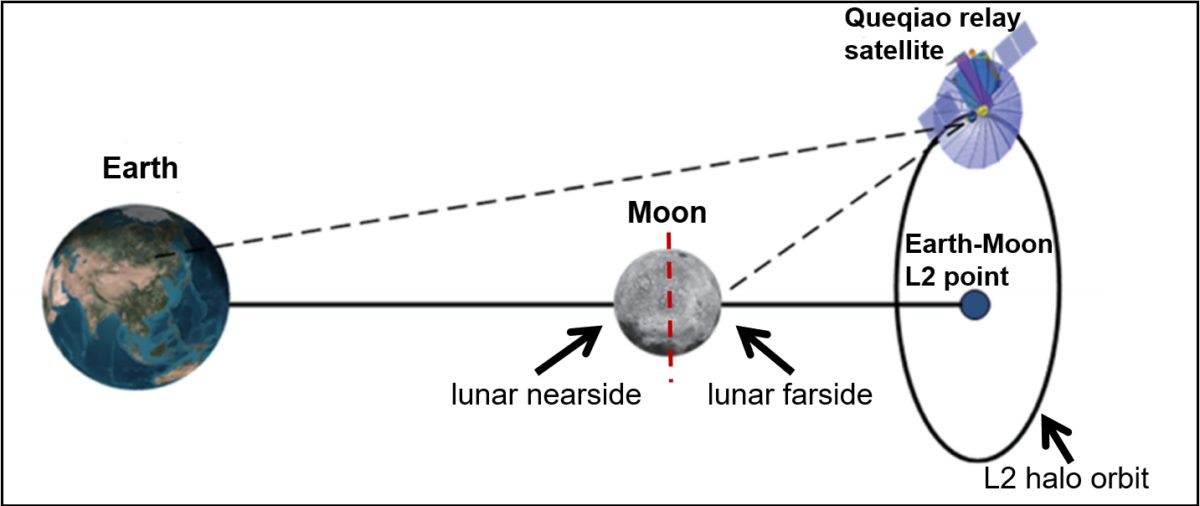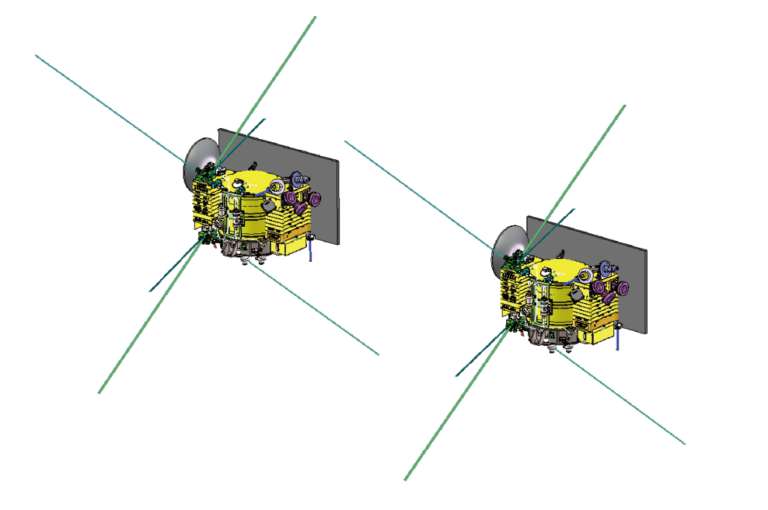Luyuan Xu • May 19, 2018
Chang'e 4 relay satellite, Queqiao: A bridge between Earth and the mysterious lunar farside
China's fourth lunar mission, Chang’e 4, is expected to begin on May 21 with the launch of a Long March 4C rocket from the Xichang Satellite Launch Centre in the southwest of China. The launch will carry a spacecraft named Queqiao, which will serve as a communication relay satellite between Earth and the lunar farside. The name Queqiao means "magpie bridge" in Chinese and comes from a Chinese folk tale, a love story about a flock of magpies that form a bridge crossing the Milky Way once a year to reunite lovers known as the Cowherd and the Weaver Girl, as well as their children.
How to pronounce Queqiao and Longjian
Chang’e 4 is planned to send both a lander and a rover to explore the far side of the Moon. If successful, Chang’e 4 will be the first-ever soft-landing mission on the lunar farside. However, huge technical challenges exist. Since the lunar farside always faces away from the Earth, direct communication between any farside in-situ explorers and the Earth is blocked.
This is because the Moon is a synchronously rotating satellite of our planet Earth, which means it rotates exactly once for each time it circles Earth. The match of spin and orbit means the moon is rotationally locked to the Earth, so we can only directly see one hemisphere of the moon (aka, the nearside) from the Earth. (Because the Moon's orbit is slightly elliptical, we actually get to peek slightly over the east and west edges of the Moon every orbit, but most of the farside remains mysterious.) Synchronous rotation is nothing unique between Earth and the Moon. Nearly all the regular satellites of the outer solar system planets, and even some exoplanets are in synchronous rotation states with their parental planet or star.
How do we have any data on the lunar farside? Orbiters circling the Moon gather data autonomously and send data back when they're in view of Earth. Humans first saw the lunar farside through a camera on the Soviet Luna 3 spacecraft in 1959. However, important scientific measurements for the lunar farside that require real-time contact with the Earth cannot be conducted directly. For example, gravity measurements by Doppler tracking, communication between a lander/rover and the Earth, Lunar Laser Ranging (LLR) measurements, and other experiments aren't possible over the farside. The first direct gravity measurement for the lunar farside was not conducted until 2007, when Japan's Kaguya m ission used a 4-way relay satellite for Doppler tracking. To enable communication from the future first lander and rover on the lunar farside, we will need a communication bridge, Queqiao.
The Queqiao satellite is 425 kilograms in weight and has a planned lifetime of more than 5 years. Both the solar panels and lithium batteries provide its energy. It will perform relay communication using a 4.2-meter diameter umbrella antenna, talking with the lander/rover at X-band and communicate with the Earth ground station at S-band frequencies. Meanwhile, the lander will also receive UHF transmissions from the rover, decode them, and send the decoded data on to the relay satellite.

Queqiao was developed by the China Academy of Space Technology (CAST). It is planned to take a lunar swing-by transfer trajectory to insert into an Earth-Moon L2 halo orbit about 8 or 9 days after launch. The L2 point is about 450,000 kilometers away from Earth and more than 60,000 kilometers away from the lander and rover on the lunar farside. An Earth-Moon L2 halo orbit is ideal for Queqiao because it can 1) provide nearly continuous contact between both lunar farside and Earth ground station, 2) get continuous illumination from the Sun, avoiding eclipses, and 3) requires little energy to maintain its orbit over the long term. The concept of using an L2 halo orbit as the location for a lunar farside data-relay satellite was proposed more than 40 years ago by Robert Farquhar, a NASA mission design specialist, and the fantastic design is finally expected to be realized by Queqiao. If successful, Queqiao will be the first-ever relay satellite at this location for lunar relay communication.

Besides its main communications function, the Queqiao relay satellite will also carry out important scientific measurements and tests. It will carry two scientific instruments.
One science instrument is a collaborative Netherlands-China Low-Frequency Explorer (NCLE) for the detection of low-frequency radio emissions from the early universe. Since the location of the Earth-Moon L2 halo orbit is far above the Earth's ionosphere and can block lots of terrestrial interference, it provides an excellent environment for low-frequency radio experiments. NCLE will carry out various astronomy experiments including mapping the radio sky for studying the galaxy, detecting solar storm and planetary radio pulses, and more.
The Netherlands Chinese Low-Frequency Explorer (#NCLE) successfully passed the last assessment by the Chinese space agency! The instrument will be launched on board the Chinese Chang'e 4 relay satellite to a position behind the Moon in May. @RadRadioLab @isis_space pic.twitter.com/dyjjrKA3Zq
— ASTRON (@ASTRON_NL) April 24, 2018
The other science instrument is a 170-millimeter large-aperture laser angle reflector, which is a test instrument to carry out laser ranging measurements between Earth and Queqiao. Therefore, Queqiao relay satellite will also exchange ranging measurement data with its Earth ground station.

In addition, two twin microsatellites (named Longjiang-1 and 2), will accompany Queqiao to the Moon. These two microsatellites are planned to fly in a tandem 300-by-3000-kilometer orbit around the Moon and carry out ultra-long-wave astronomical interferometry as well as radio-related test measurements. One of the microsatellites will also carry a micro optical camera developed by Saudi Arabia. Longjiang-1 and Longjiang-2, meaning Dragon River 1 and 2, were developed by Harbin Institute of Technology. They are named after Heilongjiang river (meaning Black Dragon River, also called the Amur River) as the institute is situated in the capital of Heilongjiang Province.

Chang’e 4 and its relay satellite Queqiao have received wide attention and hope of Chinese people, as with previous Chang’e missions. Actually, on Sina Weibo, which is the most popular Chinese microblogging website, the account ‘Yutu rover’ is a popular star that accumulated nearly 700 thousand followers during the Chang’e 3 mission.
The Chang’e 4 lander and rover are planned to launch about half a year after the launch of Queqiao.
Acknowledgments
Thanks to Dr. Jianguo Yan, Dr. Zhiyong Xiao, and Dr. Le Qiao for their comments, which significantly improved the article.
Support our core enterprises
Your support powers our mission to explore worlds, find life, and defend Earth. You make all the difference when you make a gift. Give today!
Donate

 Explore Worlds
Explore Worlds Find Life
Find Life Defend Earth
Defend Earth


